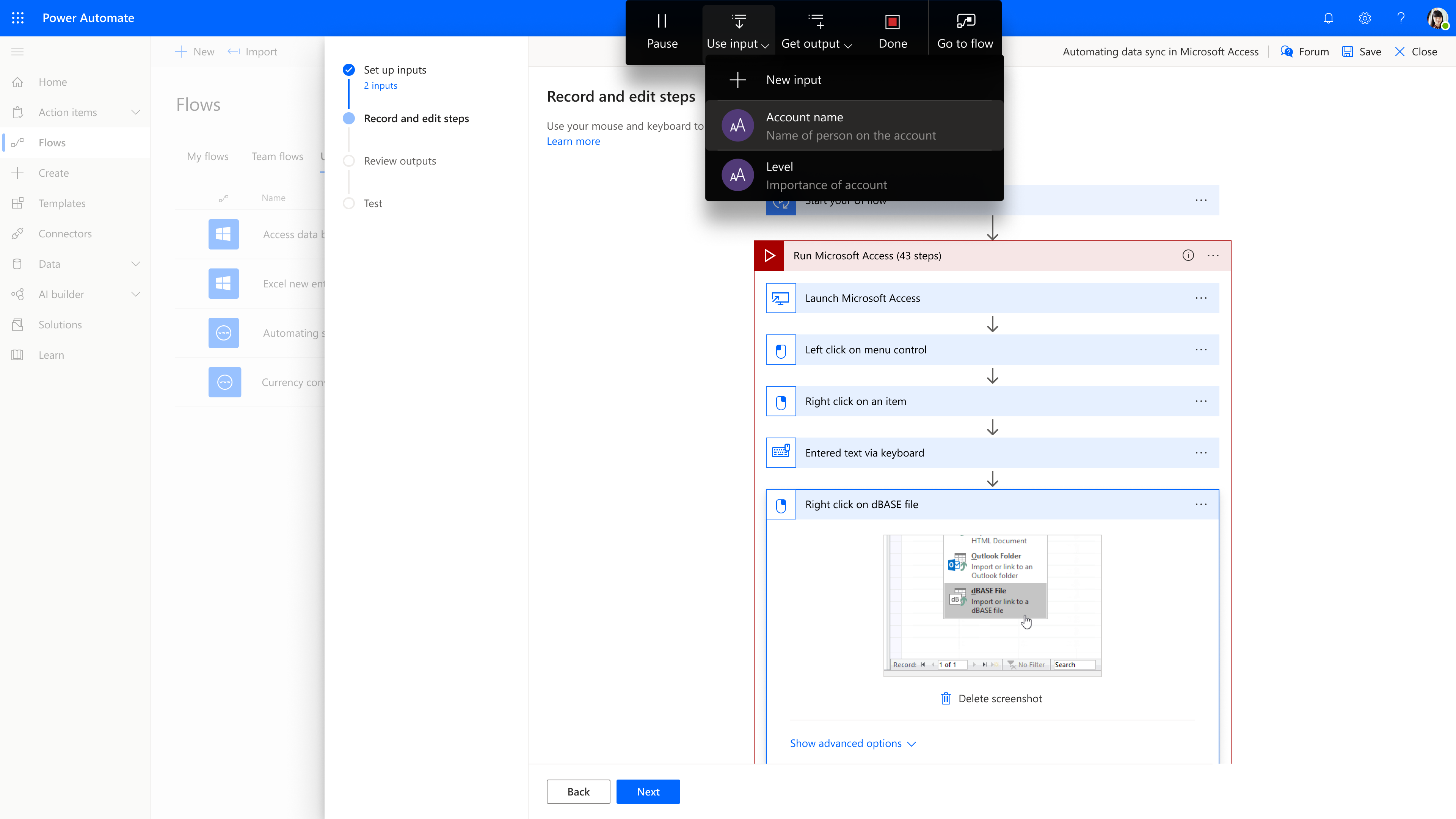
Announcing RPA, enhanced security, no-code virtual agents, and more for Microsoft Power Platform
It’s a privilege to work with global organizations every day to help them compete and innovate in a modern, data-driven economy. Our goal with Dynamics 365 and the Microsoft Power Platform is to help your organization drive more impactful business outcomes and take proactive actions that will uniquely position and differentiate your business in the fast-evolving market.
We introduced over 400 new capabilities just a few weeks ago with the 2019 release wave 2. Today, at Microsoft Ignite 2019, we’re announcing more major updates to the Microsoft Power Platform that unlock new possibilities, including:
- Microsoft Flow is being renamed to Microsoft Power Automate, to better align with the Microsoft Power Platform.
- Robotic process automation (RPA) has been added to Microsoft Power Automate, delivering an end-to-end automation solution that spans AI, APIs, and UI on the Microsoft Power Platform.
- Microsoft Power Virtual Agents—a no-code/low-code app that allows anyone to create and deploy intelligent AI-powered virtual agents.
- A host of new security enhancements for Microsoft Power BI, that add industry leading data security capabilities no matter where your analytics data is used and accessed.
- Tighter integration between the Microsoft Power Platform and Microsoft Teams, bringing the world’s most popular collaboration app and the Power Platform closer together.
- A new set of prebuilt models for AI Builder that add even more advanced AI models to Microsoft Power Automate and Microsoft Power Apps that are available to everyone.
These new features and products substantially advance our vision for the Power Platform, an unmatched set of capabilities that enable everyone to analyze, act, and automate across their organization to transform businesses from the ground up.
Be sure to watch my technology keynote today at Microsoft Ignite (or on-demand after the 11:00 AM presentation) for a deep dive into these new capabilities.
Introducing RPA in Power Automate
One of the biggest challenges organizations face is scaling and automating business processes—from digitizing pen and paper processes, to automating complex processes that span legacy and modern applications. Robotic process automation has rapidly become a key technology to address many of these scenarios but generally requires a patchwork of automation services that need integration and management before the real work can get done.
Power Automate simplifies these end-to-end scenarios through a unified automation platform that can bridge the gap between API-based automation and UI-based automation.
Today we’re announcing the preview of our new RPA capability in Power Automate called UI flows. Creating a UI flow is a simple and familiar point-and-click, low-code experience that makes it easy for users to turn manual tasks into automated workflows by recording and playing back human-driven interaction with software systems that don’t support API automation. Couple the capabilities of UI flows with Power Automate’s prebuilt connectors for more than 275 widely-used apps and services that support API automation, and you have an end-to-end automation platform capable of reinventing business processes for a wide range of workloads across industries.

For example, let’s say you work for an insurance claims processing company, where clients fill out digital forms, paper forms, or communicate through email. The claim is processed on modern cloud services while staff also maintain cumbersome paper records and legacy applications. With Power Automate, this entire process can be automated. Digitized data from scanned paper forms is processed with AI that recognizes forms, and old legacy systems can be automated with RPA—one platform that brings both worlds together seamlessly.
TruGreen, one of the largest lawn care companies in the U.S., recognizes the growing need for powerful automation capabilities.
“The need for automation at TruGreen is growing quickly, and Power Automate is, and will continue to be an important part of accelerating TruGreen’s digital transformation journey. Power Automate will help us bridge the integration gap between legacy systems and modern applications. With the new UI flows RPA capabilities, we are excited to bring automation to legacy applications with no API capability.” – Ayman Taha, CIO of TruGreen
Take a closer look at UI flows in Power Automate and sign up today for the UI flows preview.
Power Virtual Agents: Enable anyone to build a no-code/low-code virtual agent
Microsoft Power Virtual Agents, now in preview, is a new offering that enables subject matter experts in your organization – such as customer service, sales, marketing, finance, or HR – to easily create virtual agents using a guided, no-code/low-code point-and-click graphical interface without the need for data scientists or developers. Customer service questions and other types of external or internal inquiries at an organization can be serviced by a virtual agent, freeing up staff to focus on more complex tasks.

There’s no code to get started, no AI expertise needed, and you can be up and running in minutes. And because they’re already integrated with Microsoft’s Power Platform, you can use hundreds of prebuilt connectors so your virtual agents can talk to your backend systems with a few clicks – or easily add capabilities like using Microsoft Power Automate to call an API.
What’s more, if you want to add code or, say, some more complex capabilities, Azure Cognitive Services and Microsoft Bot Framework are fully integrated and just a few clicks away.
Learn more about Power Virtual Agents and sign up for the preview.
Power BI security enhancements – help protect data wherever it’s accessed
Organizations recognize the value of empowering their employees to embrace data-driven insights. Power BI helps customers drive data democratization in their organization because it enables anyone to draw insights from data with easy-to-use data visualizations and analytics to guide business decisions. As customers empower every employee with Power BI, it is critical for them to ensure that they better protect their data no matter where it is accessed.
Today we’re announcing brand new capabilities in Power BI data protection.
These enhancements take advantage of Microsoft world-class security capabilities, enabling organizations to:
- Classify and label sensitive Power BI data using the same familiar Microsoft Information Protection sensitivity labels used in Office.
- Enforce governance policies even when Power BI content is exported to Excel, PowerPoint, or PDF, to help ensure data is protected even when it leaves Power BI.
- Monitor and protect user activity on sensitive data in real time with alerts, session monitoring, and risk remediation using Microsoft Cloud App Security.
- Empower security administrators who use data protection reports and security investigation capabilities with Microsoft Cloud App Security to enhance organizational oversight.
Now in preview, these capabilities engage when Power BI is paired with Microsoft Information Protection and Microsoft Cloud App Security.
Avanade, a management consulting company, recognizes the importance of powerful data security solutions.
“Changing user behavior is difficult, but having Microsoft Information Protection data protection capabilities available to users directly within Power BI, a tool we use daily, greatly increases our confidence that our documents will be labeled and protected correctly,” said Cem Urfalioglu, Director of Avanade ITS.
In addition to these security updates, major advances in AI and natural language, Power BI integration with Azure Synapse Analytics, and more are now available. Read more about all of these enhancements and to learn how to gain invaluable insights while keeping sensitive data more secure.
Teams and Power Platform empower workers to collaborate in a data-driven business
As organizations encourage a data-driven culture, it’s important they break down silos and ensure that the right people in the organization have the data they need to be involved in the decision-making process. The pairing of Teams and Power Platform brings together the best of workplace collaboration and data-driven business into one place.
Bringing Power Platform applications to Teams means users’ dashboards, apps, and automations are available within Teams, so they are easier to find, share, and use on an everyday basis. The conversational nature of Teams enhances how users interact with Power Platform applications. For example, adaptive cards and bots let users engage with these tools directly through conversation. This integration also provides IT Administrators with high fidelity control and prioritization of features.
Power Apps creators can now publish their apps directly to their company’s app library in Teams, making them more discoverable to users and improving the experience of adding these apps to Teams. By the end of 2019, users will be able to pin Power Apps to their Teams left rail, providing easy access to regularly used apps.
New triggers and actions for Power Automate are now available within Teams. These capabilities streamline the completion of common team and personal tasks, such as scheduling focus time and automating document approvals.
New features coming to Power BI in 2020 include the ability to create rich adaptive cards in Teams conversations, which help users see and act on their data. An improved Power BI tab experience in Teams will also make selecting the correct reports easier than ever.
The American Red Cross is leveraging Power Platform integration with Teams to improve disaster response times.
“When we respond to disasters, we have to ensure communication and understanding both internally and with external partners. Workplace collaboration tools like Microsoft Teams and Microsoft Power BI enable different groups to exchange information and collaborate quickly when it’s needed most. Being able to pair that with tools made in Power Apps also helps us gather important data so we’re making informed decisions to better help people in need.” – Denise Everhart, American Red Cross Division Disaster Executive – Pacific Division.
Learn more about the enhanced Power Platform integration within Teams.
AI Builder – unlock new low-code and no-code AI scenarios
AI Builder is the no-code AI capability for Power Apps and Power Automate, made generally available on October 1st. It enables organizations to tailor AI to their specific business needs and their unique data without the need to hire data scientists or pro-developers to make their apps and processes more intelligent. AI Builder takes common AI scenarios and provides point-and-click solutions for app makers to solve everyday tasks like forms processing, object detection, and text and binary classification.
Today, we’re introducing a new set of prebuilt AI models for the Power Platform. For business users, having prebuilt AI models means they don’t have to gather data, build, or train their models. Now available in preview, these prebuilt scenarios include:
- Key phrase extraction— identifies the main talking points from your text
- Language detection—identifies the predominant language from your text
- Text recognition—extracts embedded, printed, and handwritten text from images into machine-readable character streams
- Sentiment analysis—detects positive, negative, neutral, or mixed sentiment in social media, customer reviews, or any text data
Learn more about the new prebuilt scenarios
Learn more about AI Builder in this post
Take a closer look at the new Power Platform enhancements
Browse the release notes and watch my technology keynote live or on-demand to learn more about these new updates.
Unleash your organization’s creativity and innovation with a deep dive into the Microsoft Power Platform.


